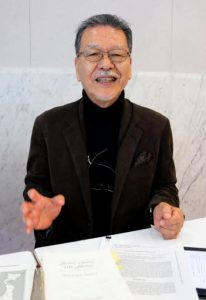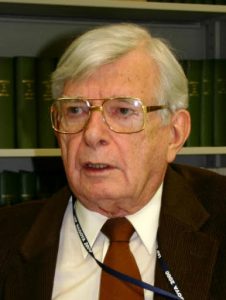Hiroshima University professor emeritus Toshima translates memoirs of William Schull, U.S. researcher, about effects of A-bomb radiation on human health: “Publication reveals scientist’s inner conflict”
Jan. 27, 2020
by Miho Kuwajima, Staff Writer
Tamotsu Toshima, 76, professor emeritus at Hiroshima University (developmental neuropsychology) and a resident of the city of Higashihiroshima, has translated the memoirs of William Schull (who died in 2017 at the age of 95). In 1949, Dr. Schull was appointed to work at the Atomic Bomb Casualty Commission (ABCC; present-day Radiation Effects Research Foundation) in Hiroshima as a geneticist. ABCC was established by the United States after the atomic bombings of Hiroshima and Nagasaki. The translated version of the memoirs, which will be released in July, describes in great detail the research in which Dr. Schull was engaged and the circumstances in Hiroshima during the U.S. occupation.
The original title of Dr. Schull’s book is Song among the Ruins (1990, Harvard University Press). He studied about 77,000 newborn infants in Hiroshima and Nagasaki and later served as RERF’s vice chairman. After returning to the United States, he collected materials related to ABCC and committed himself to establishing and opening to the public an archive at the Texas Medical Center.
Dr. Toshima learned of the existence of Dr. Schull’s book while working on a reconstruction support program implemented by the Graduate School of Hiroshima University following the nuclear accident at Tokyo Electric Power’s Fukushima No. 1 nuclear power plant in 2011. Believing that Dr. Schull’s book would “help understanding of the A-bombed city’s recovery and the inner conflict experienced by Mr. Schull in Hiroshima as an American researcher,” Mr. Toshima set about translating the publication over a period of about one year.
Mr. Schull wrote in his book: “When a baby was born, we visited a midwife and the baby’s home to give the baby a health checkup. Our blue jeeps were known everywhere,” and “If the infant was stillborn, or grossly abnormal, the attending midwife informed us immediately, and we carried out a careful examination of the baby.” He also described the hustle and bustle of the Hondori shopping street in Hiroshima’s Naka Ward, children enjoying picture-story shows, and the many friends he made in Hiroshima.
At the same time, however, ABCC was criticized for treating A-bomb survivors like guinea pigs for experimental purposes. In response, Dr. Schull wrote, “Our function was to assess and report the biological damage that had occurred.” His memoirs provide a glimpse into his consistent and dispassionate stance as a scientist.
Ohtsura Niwa, chairman of RERF, spoke about Dr. Schull. “He was someone who laid the foundation of our genetics studies.” He added, “His invaluable book draws on his remarkable memory and curiosity, which transcended the normal boundaries of a scientist in the way that he focused on the daily lives of the people in Hiroshima and Nagasaki in those times.”
(Original published on January 27, 2020)
Tamotsu Toshima, 76, professor emeritus at Hiroshima University (developmental neuropsychology) and a resident of the city of Higashihiroshima, has translated the memoirs of William Schull (who died in 2017 at the age of 95). In 1949, Dr. Schull was appointed to work at the Atomic Bomb Casualty Commission (ABCC; present-day Radiation Effects Research Foundation) in Hiroshima as a geneticist. ABCC was established by the United States after the atomic bombings of Hiroshima and Nagasaki. The translated version of the memoirs, which will be released in July, describes in great detail the research in which Dr. Schull was engaged and the circumstances in Hiroshima during the U.S. occupation.
The original title of Dr. Schull’s book is Song among the Ruins (1990, Harvard University Press). He studied about 77,000 newborn infants in Hiroshima and Nagasaki and later served as RERF’s vice chairman. After returning to the United States, he collected materials related to ABCC and committed himself to establishing and opening to the public an archive at the Texas Medical Center.
Dr. Toshima learned of the existence of Dr. Schull’s book while working on a reconstruction support program implemented by the Graduate School of Hiroshima University following the nuclear accident at Tokyo Electric Power’s Fukushima No. 1 nuclear power plant in 2011. Believing that Dr. Schull’s book would “help understanding of the A-bombed city’s recovery and the inner conflict experienced by Mr. Schull in Hiroshima as an American researcher,” Mr. Toshima set about translating the publication over a period of about one year.
Mr. Schull wrote in his book: “When a baby was born, we visited a midwife and the baby’s home to give the baby a health checkup. Our blue jeeps were known everywhere,” and “If the infant was stillborn, or grossly abnormal, the attending midwife informed us immediately, and we carried out a careful examination of the baby.” He also described the hustle and bustle of the Hondori shopping street in Hiroshima’s Naka Ward, children enjoying picture-story shows, and the many friends he made in Hiroshima.
At the same time, however, ABCC was criticized for treating A-bomb survivors like guinea pigs for experimental purposes. In response, Dr. Schull wrote, “Our function was to assess and report the biological damage that had occurred.” His memoirs provide a glimpse into his consistent and dispassionate stance as a scientist.
Ohtsura Niwa, chairman of RERF, spoke about Dr. Schull. “He was someone who laid the foundation of our genetics studies.” He added, “His invaluable book draws on his remarkable memory and curiosity, which transcended the normal boundaries of a scientist in the way that he focused on the daily lives of the people in Hiroshima and Nagasaki in those times.”
(Original published on January 27, 2020)









